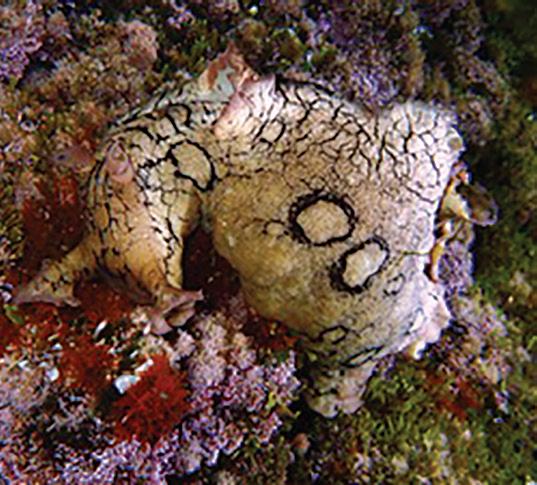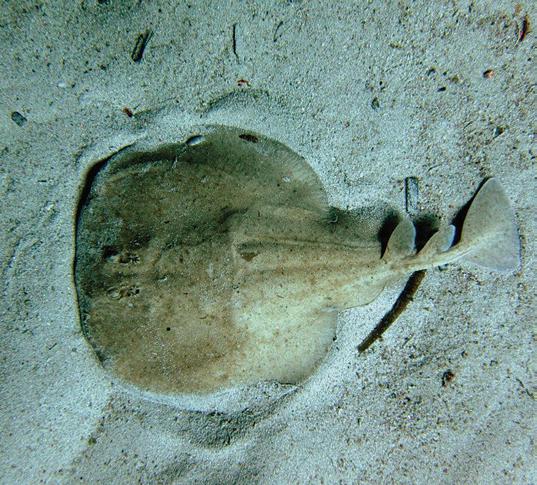
3 minute read
SNORKELLING IN THE DARK
Snorkelling at night is the best thing in the world. Switching on the torch underwater is to poke your face into a world of secrets, all hidden under a magic blanket. It’s 9.15pm as we enter the water. I make sure to bundle up, as I know that nearing 11pm I’ll be ecstatic but freezing. I wear an 8mm wetsuit all through the summer though most people get away with a 5mm, and hood and gloves. The frogman get-up is just as much for the cold as to protect my skin from brushing on a hydroid, anemone or urchin.
Our first find, in about three meters of water and under five minutes from the start, is an octopus out hunting for fish and small invertebrates. They hunt by ambushing their prey, changing their skin colour and texture a million times a minute to match their surroundings. This one is a common octopus (Octopus vulgaris) but we also get white-spotted ones, with extra-long legs (Callistoctopus macro-pus).
Moray eels hunt octopuses, and we once found a couple tangled up in a furious knot of wrath mid-water. I couldn’t figure out what it was nor believe my eyes when suddenly, amidst a puff of ink, the knot became two different animals shooting off in opposite directions. Consequently, it’s not rare to see octopuses missing their full complement of legs.
Snorkellers have a much wider angle of view from the surface, so they often spot things that divers don’t (or things that are fleeing from divers). And more importantly, they disturb the wildlife less from afar so creatures can go about their nightly business as usual. We make sure not to shine our torch directly onto the octopus, but rather, to the back of or near the animal.
As we swim along the reef, huge shoals of silversides stretch the length of the bay, like walls of ster-ling fish slivers reflecting in our torchlight. Soon we spot scorpion fish (Scorpaena spp.) on the sand. Camouflaged on rocks by day, by night they move out into the sand, and lie in wait. As with the octopus, an ambush is the strategy of choice. Voracious hunters, it’s not long before they strike: after a night’s worth of rapid forward hops there’s quite a few fish less in the sea. The one in the picture is stealing my torchlight to attract its prey.
A couple of fin flips ahead, a female electric torpedo ray (no claspers in sight) has come out of the sand and is pondering her next move. She has two large lobes on the side of her head which act like battery terminals. Once she chooses her victim, the ray wraps itself around it and stuns it with over 200 volts. Though, somewhat reassuringly perhaps, the amps are too low to kill humans outright.

As we near the exit of the bay, shoals of squid (Loligo vulgaris) appear in the distance. Their red colour and glowy-turquoise bioluminescence give them


BY RACHAEL ADAMS
away. So too do their flitty movements as they shoot jets of water from their siphons. Squid are nocturnal, spending the daytime out in deeper waters and coming into bays at night to hunt. They catch shrimp and small fish. Fishermen use lights to catch them and take a better haul on the new moon: the darker the better.
Squid lay their eggs in long dangling tendrils under rocks, and the young are better known to us battered on a plate as chipirones. On one occasion we found a solitary bobtail squid (Sepiola spp). These little guys hide in the sand during the day.
As we turn back towards the beach, we find a spotted sea hare (Aplysia dactylomela). What we call their “ears” are actually “rhinophores” used for sniffing rather than hearing. The bottom two curled “oral tentacles” are also for smelling and feeling. These huge sea slugs are algae grazers, so they’re often found quite close to the surface. In fact, they’re so good at guzzling weeds that you can rent one (in America) to clean your fish tank if you (really) need to!
Though boring in term of colour compared to many of their cousins, these fatties are still poisonous so don’t poke them or they’ll ooze an irritant pink purply plume of death at you. During the daytime, they pretend they’re innocuous and sleep under rocks.
Just before the exit, in the shallows, we discover the relatively small sand eels (Ariosoma baleari-cum), or more scarily, “band tooth congers”. They hang motionless, camouflaged against the sand with their white, scaleless bodies, hoping I haven’t seen them. Shy little things at around 40cm long, if I do get too close, they shoot backwards into the sand leaving just the head poking out the top!

A word of warning for snorkellers that get so carried away they stay out all night until the sun comes up. Never stray from the edges and always, always take something big and yellow to wave at an on-coming boat. Scream if you must. I clip water bottles and cameras to my buoy. The chance to take a smoothie break on the surface by standing on a submerged rock pinnacle is a big advantage over diving. Though to see the squid eggs up close for any length of time you would have to book a dive as they are in 14m of water. Under an undisclosed mystic rock.
Barcelona University has a good website for species id (https:// www.cibsub.cat/guia.php) and Dive Centre Cala Blanca offer guided snorkel tours.
Dive Centre Cala Blanca, Avinguda de Cala Blanca, 07769 Cala Blanca, Ciutadella de Menorca
(+34) 642 682 704










